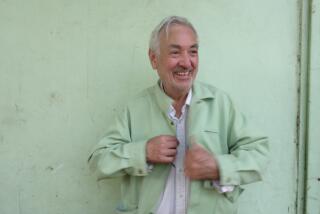Robert Gumbiner dies at 85; HMO pioneer founded Museum of Latin American Art
- Share via
Robert Gumbiner, a physician and HMO pioneer who built the managed-care giant FHP and then used his fortune to found the Museum of Latin American Art in Long Beach, has died. He was 85.
Gumbiner died of prostate cancer Tuesday at his Long Beach home, said Susan Golden, a museum spokeswoman.
“I know something about building things,” Gumbiner -- pronounced Gum-buy-ner -- told The Times in 2007 while discussing the museum he started in 1996. “In my former career, I built 55 medical centers and four hospitals in nine states.”
He considered the medical community’s traditional practice of charging fees for individual services “basically immoral” because he said it meant doctors earned the most when patients were sickest.
By 1962, he had converted his group medical practice into a nonprofit corporation that eventually became FHP International, a pioneering prepaid health plan that grew into a managed-care empire with more than 1 million members.
“Dr. Gumbiner was on the cutting edge of managed healthcare before other people knew how to spell it,” Charles Steller, then an executive with American Managed Care and Review Assn., said in 1990 in The Times.
FHP was one of the first HMOs to embrace government-assistance programs for the poor and elderly when others thought them too risky. As of 1990, it was widely regarded as one of the best-managed HMOs in the industry, a fact that observers credited to Gumbiner’s no-nonsense management style.
“The guy was a genius and just knew a lot about everything,” Nick Franklin, FHP senior vice president of public affairs in the early 1990s, told The Times. “There’s a quote about him that goes, ‘But for his bedside manner he would be one of the stars of the industry.’ He was a pretty tough bird.”
When Gumbiner stepped down as chief executive in 1990, FHP was one of the largest HMOs in the nation.
The company’s growth reflected his interests, expanding into Utah, where Gumbiner liked to ski, and Guam, where he went scuba diving. He was also passionate about Latin American art, which he collected during 30 years of travel.
His 250-piece art collection had long outgrown his home, spilling over into an adjacent house that Gumbiner bought because his neighbor’s dog would not stop barking.
Ousted as FHP’s chairman of the board in 1995, Gumbiner soon announced plans to transform a Long Beach building he owned into a museum for Latin American art.
Gumbiner and the foundation he established in 1990 to support the arts spent more than $40 million, according to the museum, to renovate and expand the building, which once housed a skating rink. It bills itself as “the only museum in the Western United States that exclusively features contemporary Latin American fine art.”
Judged against contemporary art museums that focus on the U.S. and Europe or aim for a global view, Gumbiner’s museum has “a very conservative collection” that is largely composed of figurative paintings, according to Times arts writer Suzanne Muchnic.
But it reflects his interest in niche collecting and his wish to educate the public about Latin American art and artists. The museum houses a 1,000-piece collection that represents 20 countries. Almost 60,000 people visited it last year.
Gumbiner left “a sizable endowment” to the museum, Golden said.
He acquired the piece that started it all -- “Depressed Woman,” an oil painting by Eduardo Kingman -- when he traveled to Ecuador in the 1960s while volunteering for a humanitarian program. He was drawn to Latin American art because it was easy to understand and identify with, Gumbiner said in 2005 in Latino Leaders magazine.
In 1994, he founded another major art project, the Ethnic Art Institute of Micronesia on the island of Yap, to revive the lost ethnic arts of the Micronesian people.
He was also working on a museum in Long Beach dedicated to Pacific Island and Micronesian art that is scheduled to open this year.
The son of a doctor, Gumbiner was born Jan. 31, 1923, in St. Louis and studied medicine at his father’s insistence. He earned a bachelor’s degree in 1944 and a medical degree in 1948 from Indiana University.
A year later, Gumbiner and his wife drove west to Long Beach. He worked at Orange County General Hospital and a San Pedro clinic operated by Ross-Loos -- one of the original HMOs -- before serving in the Air Force during the Korean War.
In 1955, he and nine other physicians formed a private practice in Long Beach that began offering a prepaid medical plan. Although the plan was successful, the other doctors feared a loss of income and eventually voted to get rid of it, Gumbiner had said. The dispute led to the breakup of the partnership and to the founding of FHP.
“When he set up his first prepaid healthcare plan, the medical community really thought it was anti-American,” said Franklin, his former colleague.
“He was really changing the way the healthcare world worked at the time.”
Gumbiner, who was divorced, is survived by three sons, Burke, Lee and Jay; a daughter, Alis; and five grandchildren.
A memorial service will be held at 2 p.m. March 15 at the Museum of Latin American Art, 628 Alamitos Ave., Long Beach.
Instead of flowers, the family suggests donating to the museum, www.molaa.org.
More to Read
Start your day right
Sign up for Essential California for the L.A. Times biggest news, features and recommendations in your inbox six days a week.
You may occasionally receive promotional content from the Los Angeles Times.







